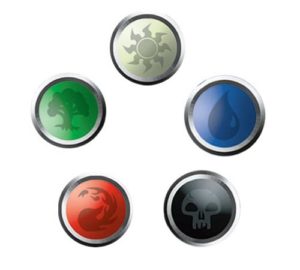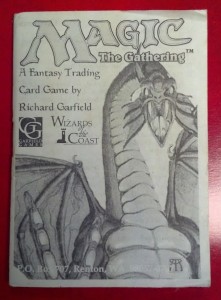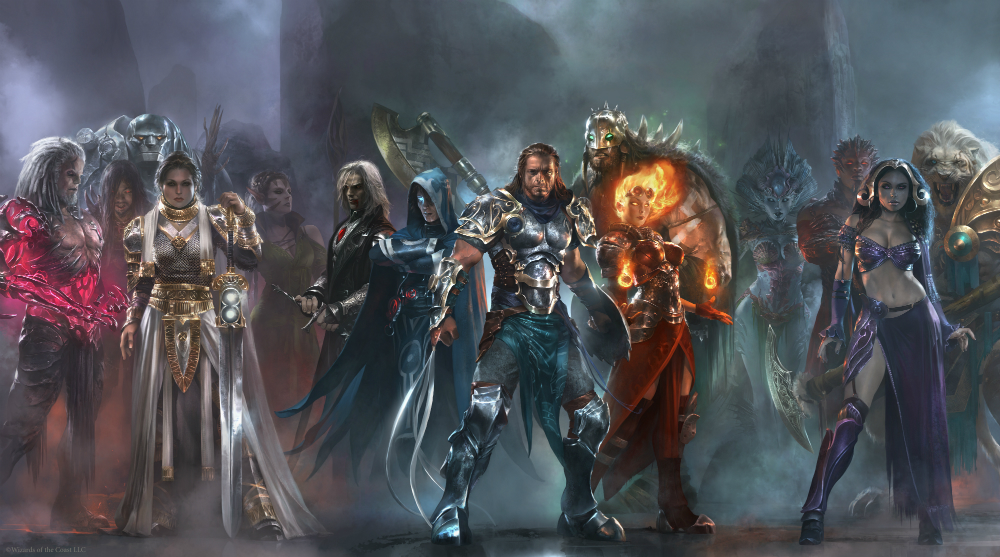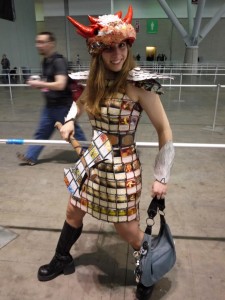Congratulations planeswalker. You are one of the extremely rare spellcasters with the means to travel between worlds. It’s a gift, a very special gift. Just be wary that there are others like you out there, and they don’t all get along…
The Premise
 Players represent massively powerful wizards known as planeswalkers. Planeswalkers have the ability to jump to many different fantasty-style worlds, and their existence is extremely rare. Your goal is to drive the other players from the Multiverse known as Dominia (or, at least it used to be).
Players represent massively powerful wizards known as planeswalkers. Planeswalkers have the ability to jump to many different fantasty-style worlds, and their existence is extremely rare. Your goal is to drive the other players from the Multiverse known as Dominia (or, at least it used to be).
You know, by killing them.
Players create decks of cards from their collection, and then they use these decks to do battle with their opponents. Deck styles vary wildly, but they all contain at least one of the six different schools of sorcery, depicted as different colors:
- Black: Unbridled ambition. This is the color of death, destruction, and greed. These mages are not always necessarily evil, but they always seek greater power at their own expense – or the expense of others. That’s just the price of doing business. Black draws its energies from Swamps.
- Blue: Logic. Reason. Knowledge. This is the color of the water, the skies, and the boundless options they represent. Blue mages value intellect and often prefer to deal in deception and manipulation over direct conflict. That is, if they prefer to act at all. Blue draws its energies from Islands.
- Green: Life and growth. This is is the color of lush landscapes, and here, the laws of nature triumph over all else. Green mages value the raw strength that the natural world provides, and have no hesitation demonstrating this on their opponents. Green draws its energies from Forests.
- Red: Action and emotion. This is the color of fire, earth, and the chaotic powers they possess. Red mages don’t wait around long for much, and they’re easy to provoke. When roused, though, Red will bring its full frenzy to bear, probably right on someone’s head. Red draws its energies from Mountains.
- White: Law, order, and organization. This is the color of hope and peace. These mages see the world through a moral lens, and they seek to bring balance to it however they can. Whether it is to marshal armies or summon divine assistance, White’s sword of judgment falls decisively on the unworthy. White draws its energies from Plains.
- Colorless: Not a formal school per se, Colorless magic represents two types of cards outside any particular color: Lands and Artifacts.
The Rules:
When Magic: the Gathering first started, a small rules booklet was included. As the game grew and the rules became more expansive, this became less and less viable of an option. These original wallet-sized rulebooks came complete with examples, terminology, and even a sample game. Eventually, it reached a point where the game had become too complex to continue to do this, and other methods were used – like this thing called the Internet.
Today, the Basic Rulebook is available on the website of Wizards of the Coast, the owner of the game. Alternatively, Wizards often touts the learning tools and tutorials provided in their video game series, Duels of the Planeswalker. The “full” rule set, the Comprehensive Rules, spans all 20 years of the game, is almost 200 pages long, reads like a law book, but it is not required reading. In today’s age, much as it was in the beginning, most new players are taught by other players. Remarkably, the core game has not changed much since it started.
In contrast with most games, Magic is not an “out of the box” format. That is, unless a player purchases a pre-made deck, they need to first construct one in order to play. Deck construction, at the very least, requires that a deck be a minimum of sixty cards, and aside from the five Basic Lands, there cannot be more than four copies of the same card. Each deck will also contain some of the card types the game has:
- Lands: Lands, such the Basic five (Swamps, Islands, Forests, Mountains, Plains), let the player use the color of energies, called mana, they represent. There are many other Lands that provide other abilities as well, though.
- Creatures: Creatures are various beasts, dragons, elves, zombies, spirits, and many, many, other monsters that you can summon to your side. They are used to defend yourself as well as attack other players.
- Sorceries: Sorceries are powerful but temporary spells that provide you with a worthwhile effect. They can only be played at certain times on your turn.
- Instants: Similar to Sorceries, Instants are also useful but temporary spells. They tend to be more situational and less potent, but they can be played at almost any time.
- Enchantments: Enchantments represent magical effects that have been created, and these effects stay around as long as the card does.
- Artifacts: Artifacts are magical constructs. Some are animate creatures, others are forged weapons or tools. Artifacts represent magical items in the world. Their abilities often provide effects outside a color’s normal realm, albeit less efficiently.
- Planeswalkers: Planeswalkers are in-game characters that represent other powerful mages such as yourself. They can be summoned to your assistance and provide you with a powerful ally, so long as their loyalty hold out.
Each player starts with their deck and 20 life. Each player draws a hand of seven cards, and the first player is determined randomly. Players takes turns drawing cards, putting out Lands, and using (“tapping”) those Lands for its mana to cast spells. Then the next player does the same.
The turn structure is broken down into five phases:
Beginning Phase: Here, the current player refreshes (“untaps”) any cards that were used previously, preforms an upkeep of any cards that require it, and draws a card.
First Main Phase: This is when will be able to cast a Sorcery. It will also be the first time you will be able to put a Land, Creature, Planeswalker, Artifact, or Enchantment into play. (Collectively called permanents)
Combat: This is when you can use your Creatures that didn’t come out the same turn to attack other players.
Second Main Phase: Just as the First Main Phase, you have all the same opportunities to cast spells. However, you can only play one Land a turn.
End Phase: Here, you deal with any cards that require action at the end of turn, and then you discard down to seven cards.
These turns continue until only one player remains alive.
Here be Dragons
Magic: the Gathering has been synonymous with collectible card games since it was created in 1993, partly because it’s the game that invented the idea, and partly because it’s been far and away been the most successful. It has far outlasted most of its competitors. It’s popular to dismissively assume this dominance is because Wizards of the Coast is owned by by Hasbro, and therefore it’s the product of a big corporation. While it’s true that, in the past, Hasbro threw its weight around and knocked out some competition, it’s a bit disingenous to assume that this is the game’s only reason for success.
For one, there is the visual appeal. From the game’s inception, the artwork has been a hallmark. From its diverse talent pool in its early years to dazzling pictures for even the most innoculous cards of today, the art of the game shines. Each world the game visits uses the artwork to impart a distinct theme and a reflection of what is transpiring. The storyline for these sets is displayed through its artwork even more than the mechanics do, and few games invest the kind of money into artistry that Magic does.
It is ironic, in that sense, that Immersionists are a coin flip with this game. On the one hand, a Magic set has a very rich world-building feeling. You get a sense for the environment, the conflict, and the characters through the cards or supplementary material, in the way that Immersionists love. On the other, the actual gameplay doesn’t alter too much because of that theme, aside from a new mechanic or two. Moreover, once cards from different sets are mixed together in decks, any overarching the theme aside from “you are a planeswalker” gets heavily diluted – and even that flavorful aspect is usually forgotten. It becomes rote strategy at that point. As that thematic feel wanes, so could an Immersionist’s interest.
For Socializers, it is a similar plight. Magic is a very social game by its nature if the players allow for it. (You might not get a ton of conversation with highly organized environments, but Socializers will prefer the more casual settings anyhow.) They will be enticed by this game’s socializing potential. However, the game does have a learning curve that could be intimidating to get past. While one doesn’t have to be a rules judge to enjoy the game, if they feel stymied by the complexity of the game, Socializers will likely abandon interest.
In general though, the game offers something for most groups. Above all else, this is a game of strategy. You are always scheming, plotting, acting, reacting. It is a test of mettle against your opponents, and Strikers are generally on board for that. Since this is a card game, there is some randomness to the deck draws and players interfering with your actions, but that can be mitigated as much or as little as you wish by your deck style.
Likewise, Tacticians and Architects are right there with them. Whereas Strikers will probably want up-tempo games, you can expect these two archetypes to focus more on the long game. Tacticians will find ways to deflect and deter aggression towards them as long as it takes to pull off whatever complex concoction their deck is supposed to do. Architects, alternatively, will enjoy being able to build up lots of whatever they want to have masses of (creatures, artifacts, mana, etc.) and then make their move. Whereas a Striker may want to whittle their opponents down bit by bit, Architects will wait until they have enough resources to crush you in one fell swoop…
As for swooping, how do you feel about a deck that uses only Bird creatures? Or one that uses four colors because “Blue is dumb”? Or one that revolves around not having any cards in your hand? Or one that makes everything that happens in the game be as chaotic and random as possible? Luckily for Daredevils, all of these (and many, many more) are possible. Chances are, if there is in-game support for their zany concept, it can be done.
The Red Sox & Blue Jays
For all of the positive things about Magic, it is not without its issues. When you break those down, though, the complaints falls into four categories:
1. The Time & Financial Cost: Granted, this is the same charge that can be levied against any expansive card-based game. Collectible cards games such as Magic, Yu-Gi-Oh, Pokemon, or L5R will always deal with this fact, as buying and trading cards is part of its core concept. You will buy randomly-assorted packs in the hopes of finding cool cards you may want, or you’ll take to the secondary market to purchase individual cards. The more powerful or more popular cards will always be at a premium, and over time this all has a toll on the wallet. Then you have to sit and create/tinker with decks. It has been shown time and again that players can make successful decks with little cost, but this is not the norm. The more competitive your decks become with friends or in an organized setting, the more this drives up your investment.
Take baseball payrolls. In modern baseball, The New York Yankees and Boston Red Sox spend ungodly amounts every year on salaries to bring in the best talent they can afford. They do this to compete with one another on a very high level. Their payrolls are 2-3 times that of the rest of the teams in the division. Now, they generally win a lot of games for that investment. A lot of games. In fact, those two teams combined have represented the American League in 9 of the last 19 World Series, and they won 7 of those 9 times. Sure, teams do win the championship with a fraction of the cost of their competitors, but a lot of things have to work in their favor.
The same thing happens with Magic. The more competitive you become, the more you are going to want to spend cash to improve your odds. If you don’t care to (or are unable to) spend that extra money, a disparity between deck strength can occur, forcing some players end up with a feeling of futility. They feel that players essentially buy wins, and that feeling isn’t entirely unfounded.
2. Legalese: While the core concepts behind Magic aren’t more complex than most strategy-heavy games, becoming proficient in all the nuance takes time. Do you know what APNAP is? The Layer System? Dependencies? No? It’s ok. Most players don’t, and for the vast majority of games, these complicated rules don’t come into use. The issue arises when strange interactions do happen, and the outcome is unknown or ambiguous. Players then have to go seeking gurus or consulting the Tome of Many Rules to find an answer, detracting from actual gameplay. What’s worse are occasions when some players use obscure rule interactions as a tactic against other players. The game designers try to mitigate these issues if possible, but in a game with thirteen thousand unique cards (and growing), there will be times when judgement calls in games will have to be made.
3. The “Right Way” to Play: When Richard Garfield created the game, he designed it mainly around a two-player duel. In a time span that probably lasted all of 15 minutes, games of more than that formed. Since then, Magic has become a game that caters to a number of different types: the competitive duelist, the casual “kitchen table” crowd, drafters, and those who prefer multiplayer politics. In that sense, there isn’t just one game of Magic: the Gathering – there are many. Officially sanctioned formats or not, it’s clear that the game is popular for many groups.
Overall, this is considered a great asset, but there is the eternal argument among the player base over what is the most important format. Which one is the “true” style to play the game? What’s more, when sets come out that don’t cater to their prefered style, there’s immediately complaints of favoritism lobbied at the developers.
4. The Player Base: Much in the same way you shouldn’t assume that all D&D players are anti-social, single guys living at home, one shouldn’t assume with Magic either. Child and adult, men and women – the game has fans across the geek spectrum. What is true, however, is that the bulk of their demographic is males aged 15-30. Since this is a sizable portion of the community, it’s also the most visual. Couple this with the fact that many local game stores tend to heavily cater to the CCG crowds (since selling card singles have better margins than boxed games) and that it can be intimidating learn to begin with, and you can see how this tends to perpetuate the notion that the player base is insular and not all that inviting. One just had to be aware that such groups don’t reflect the community as a whole.
The Takeaway
Magic, by its nature, is very open-ended, whether that means the types of decks one can build or the variety of ways the game itself can be played. This permits players to experiment with new ideas, but it’s more than that. The game allows players to make decks that are as wacky and eccentric or as competitive and serious as they wish them to be, as the decks are an expression of what the player enjoys from the game. The game continues innovate even into its 20th year of existence.
That said, Magic is not for everyone. Like minis games, CCGs have a tendency to become a hobby or an investment all on their own, requiring a bigger time and/or money focus than a stand-alone board game. If that doesn’t deter you, and you can find groups of like-minded play styles, you won’t be disappointed. Whether it’s the artwork, the stories, or the strategy, Magic: the Gathering casts a wide enough net to entice a more diverse player base than it may first appear.
Cardboard Republic Snapshot Scoring (Based on scale of 5):
Artwork: 5
Rules Clarity: 2.5
Replay Value: 5
Physical Quality 3
Overall Score: 4



